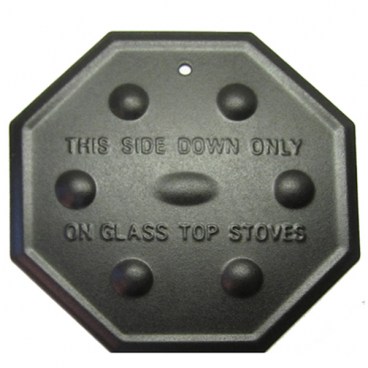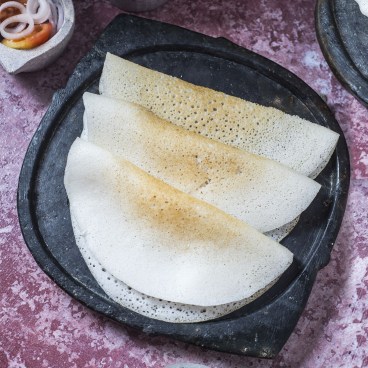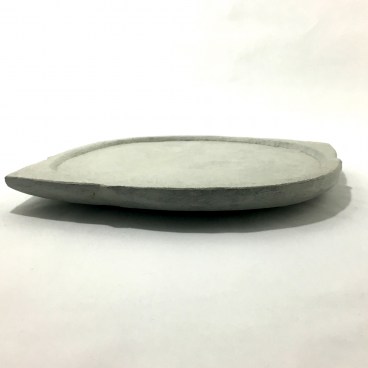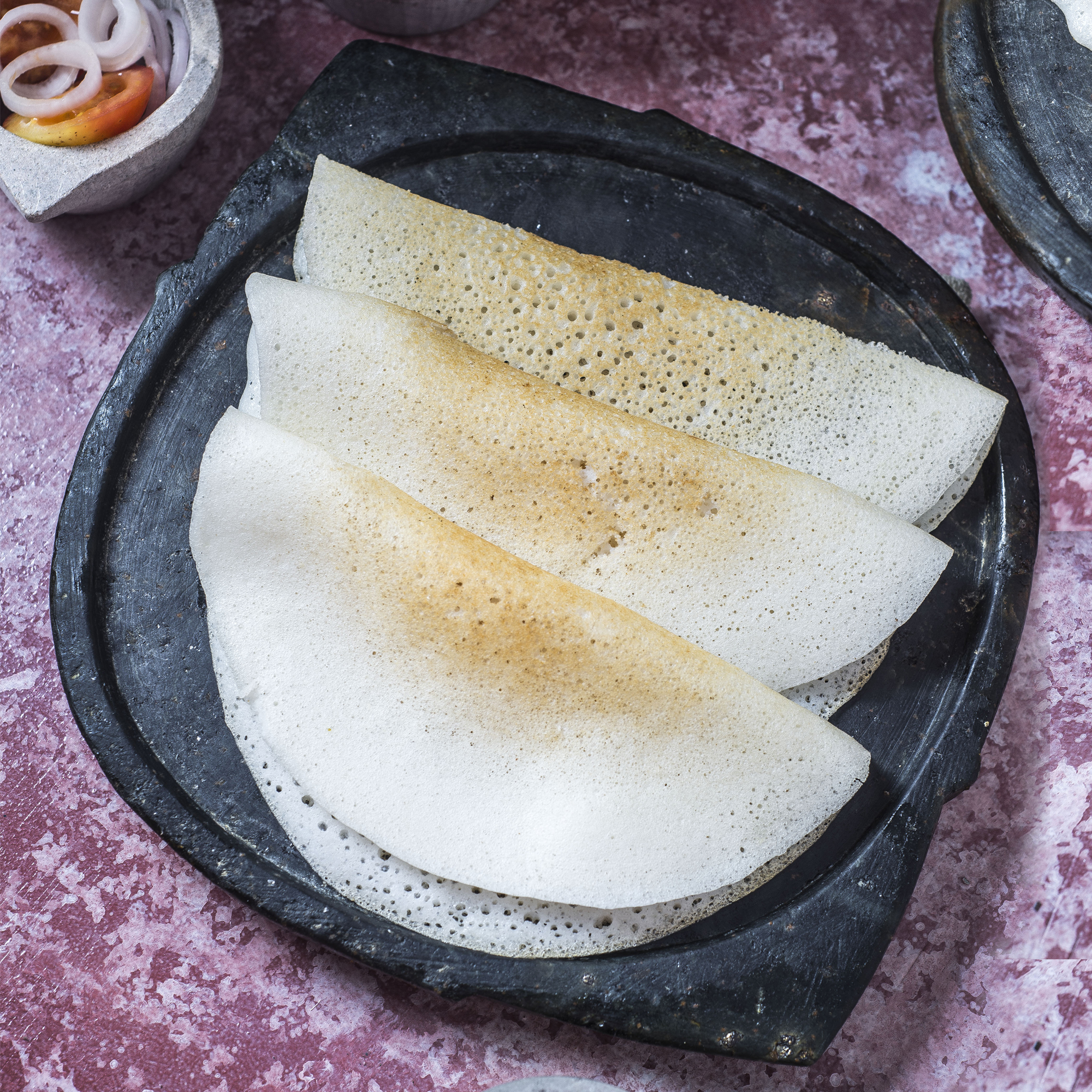
Indian Soapstone Tawa

About the piece
Care and Use
Curing
Recipes
Although normally made of cast iron or aluminum, these special Tawas made in North Tamil Nadu, are made from soapstone. Not to be confused with stoneware, which is a kind of clay fired at high temperature, these soapstone Tawas are actually handcrafted from a single block of natural, non-toxic soap stone which allows them to withstand high temperatures and stays hot for a very long time. The beautiful stone also makes for a stunning and exotic presentation.
It is very important to properly cure a soapstone following the instructions carefully. If not properly cured, the stone may crack during use. See the tab on curing for instructions..
Tawas are used to prepare all kinds of roti or Indian breads ranging from Chapatis and Parathas to Dosas and Cheelas.
| Small | Large | |
| Item Number: | IND-7025-11 | IND-7025-13 |
| Dimensions (inches, approximate): | ||
| Length: | 12 | 13 |
| Width: | 10 | 11.5 |
| Height: | 1 | 1 |
| Diameter: | 8.5 | 9.5 |
| How we measure |  |
Appearance
In their natural state, they are light in color, however they need to be cured before its first use which will cause it to turn a darker shade of grey, but still maintain their beautiful stone pattern resembling granite.
Pots can vary in color and hue from each other depending to the exact composition of the minerals in the stone therefore making each piece unique.
As with most handmade products by artisans around the world, the pieces may have slight imperfections in the form or finish of the materials, however, these imperfection do not compromise the aesthetics or functionality of the pieces and are considered normal and to be expected.
Soapstone tawas can be used on a stovetop or grill, and can go directly to the table for a sophisticated presentation. The pieces can be used directly on a gas or electric range, however, it is recommended to use a heat diffuser on electric ranges. The heat diffuser (which can be used with gas stove as well) has the added benefit of distributing the heat slowly to prevent foods from burning. The tawas can also be used on induction cooktops with the use of an induction cookware interface disk.
 To use a soapstone tawa, first it must be cured. Follow the instructions under the curing tab. After cured, place the tawa on a low flame (low heat) for 5 minutes to begin to use it. Take an onion and cut into two halves. Take one half and dip the cut part in oil. Use this to grease the tawa.
To use a soapstone tawa, first it must be cured. Follow the instructions under the curing tab. After cured, place the tawa on a low flame (low heat) for 5 minutes to begin to use it. Take an onion and cut into two halves. Take one half and dip the cut part in oil. Use this to grease the tawa.
Switch to low medium flame, and your Tawa is ready to use.
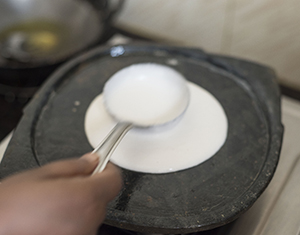 To make dosa, take a ladleful of fermented dosa batter and pour it over tawa. Spread the batter in clockwise direction with the help of ladle to form a large disc just like we do to prepare pancake.
To make dosa, take a ladleful of fermented dosa batter and pour it over tawa. Spread the batter in clockwise direction with the help of ladle to form a large disc just like we do to prepare pancake.
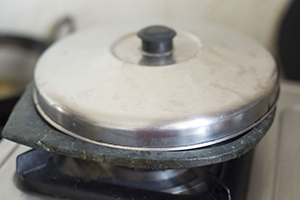 Pour a tsp oil all over dosa and close the Tawa with a lid and let it cook for 2 minutes.
Pour a tsp oil all over dosa and close the Tawa with a lid and let it cook for 2 minutes.
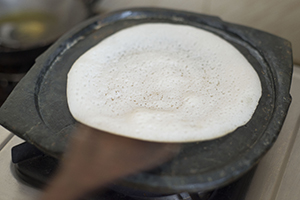 Remove the lid and carefully remove dosa with a flat ladle and proceed with the remaining batter and repeat.
Remove the lid and carefully remove dosa with a flat ladle and proceed with the remaining batter and repeat.
The tawa must not be submitted to drastic changes in temperature and should be allowed to adjust slowly to heat, letting them slowly heat up until they are hot, either on the stove or in the oven. Likewise, you should also allow the tawa to adjust to room temperature before washing or storing them, and never sit a hot tawa on a cold surface such as granite or tile.
The tawa retains heat for a long period of time, so be careful in handling a hot tawa.
For cleaning, avoid using the dishwasher, hand washing is recommended. After each use scrub the tawa lightly with a sponge or soft cloth. It is a good idea to reapply some oil before storing the tawa.
Do not use metal or abrasive pads as they may scratch the surface and avoid strongly scented soaps which can flavor the tawa. Use wooden utensils with the pieces as metal utensils can scratch and damage the inside.
Before Indian Soapstone Pots and Pans can be used for cooking the first time; it should be “cured”. The curing process not only seals the pores of the stone, but it also further hardens the soapstone and makes it last longer. It also makes the pan more resistant to sticking. Since it the color becomes more intense and a darker shade of grey, some people feel they are even more beautiful after the curing process.
The process can be seen on the video on the right. To begin the process, rinse the pan well under running water to remove any dirt left over from the manufacturing or shipping process, and let completely dry.
After the pan is completely dry, coat the pan both on the top and the bottom with a generous amount of castor oil. Then sprinkle turmeric powder on the entire surface and make sure to rub the powder evenly over the entire pan, both top and bottom. You might want to use protective gloves to make sure not to stain you skin or nails. Place the pan in cool dry place and let it rest overnight. Repeat this process for four (4) days, reapplying more oil and turmeric each time.
After the turmeric and castor oil process, wash the pan well to rinse of the residue and place it in large pot filled with hot rice stock water, or kanji vellam (the starchy water left over from cooking rice) and leave it sit overnight. The following day, boil the water until it is completely dry. Repeat the process for four (4) days in a row. You will be tempted to use your beautiful pan, but finish the process to ensure it does not break.
After the final boil, you can rinse it well under running water, and begin enjoying your Indian Soapstone Pan.
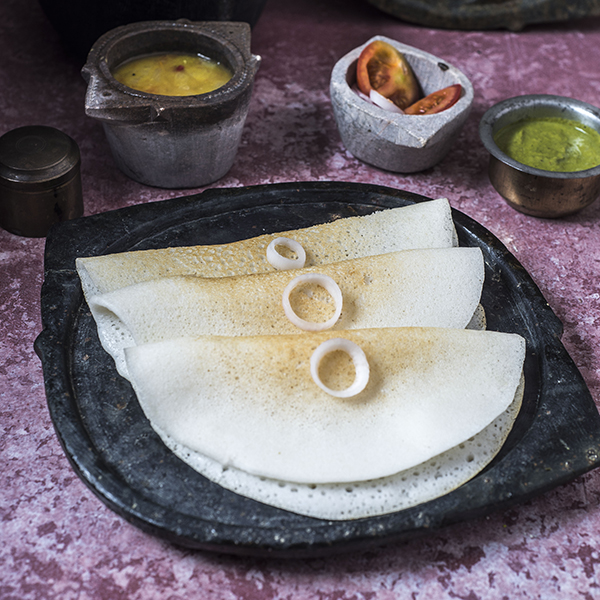
Kal Dosa
A spongy, crispy and healthy south Indian style pancakes which are not only nutritious but also easy to prepare. Prepare this for breakfast or dinner and serve with chutney or dal.


